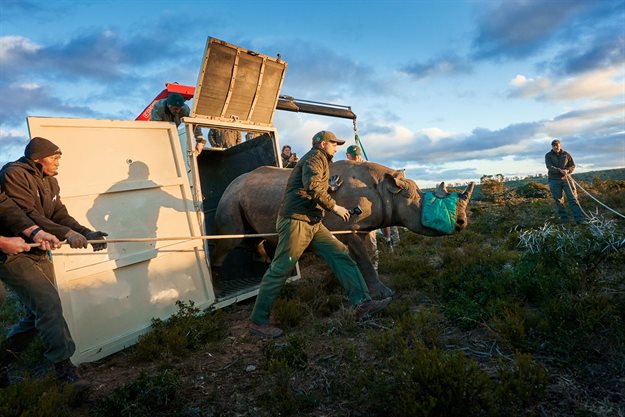
Subscribe & Follow
Advertise your job vacancies
WWF-SA Black Rhino Range Expansion Project completes 12th black rhino move
Now in its 16th year, the WWF-SA Black Rhino Range Expansion Project (BRREP) has just completed its 12th successful black rhino move, including translocating its 200th rhino. This project, as part of an ongoing initiative to increase the growth rate of the critically endangered species, actively seeks out new areas to establish populations of black rhinos where they have space to breed and increase their numbers.

An airlifted black rhino gently being lowered to ground. © WWF/Micky Wiswedel
For the latest move, BRREP joined hands with private landowners, a community and the provincial government in the Eastern Cape, to create a 14,000 hectare reserve. All of them are now the joint custodians of the group of black rhinos.
Prior to the move, the site was thoroughly assessed for security and habitat suitability using best practice standards. The privately owned section of the new project site has been converted from farming to conservation and was recently declared a protected area. A local community of 25 families has agreed to lease a portion of their land in exchange for rental that will help them fund a farming initiative elsewhere on their property. A third portion of the land is managed by the Eastern Cape Parks and Tourism Agency.
A SANParks game capture team was contracted to carry out the translocations using a combination of helicopter airlifts and road transportation undertaken smoothly over a four-day period.

200th rhino leaves crate on to new home. © WWF/Micky Wiswedel
Following the recent move, BRREP project leader Dr Jacques Flamand commented: “We work with extremely professional and experienced teams to ensure the success of these translocations. As veterinarians, our first concern is for the welfare of the black rhino in our care.
“This move has gone very well so far and we are monitoring the animals closely. They are all still exploring the reserve and some are starting to show signs of setting up home ranges already.
“It usually takes a couple of months before they have all completely settled. Their new home is wonderful habitat for black rhino, so we’re very pleased and hopeful that they will contribute meaningfully to the numbers of this endangered species.”
Related
Using radiation to stop the traffic of rhino horns 16 Oct 2024 Using carbon dating to stop elephant and rhino poaching 25 Sep 2024 Public comment sought on rhino management plan 20 Jun 2024 Judge rules for 'road' in legal clash with 'toads' 24 Apr 2024 Namibia investigates surge in rhino poaching in Etosha park 3 Apr 2024 'Animal activist' arrested for illegal possession of rhino horns 29 Dec 2023









